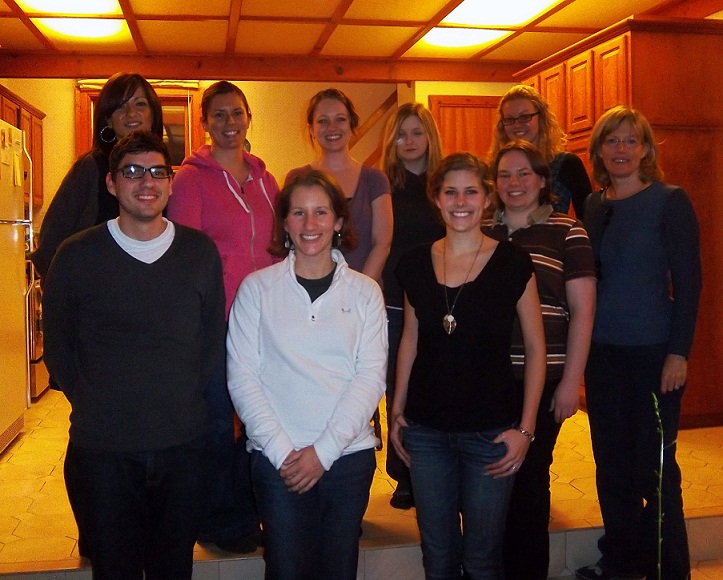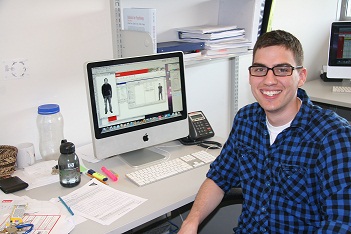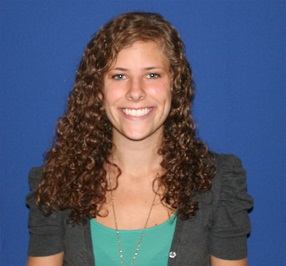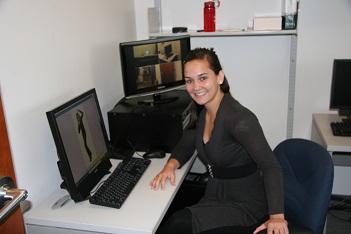|
Welcome to the Infant &
Child Development Lab
PEOPLE
IN THE LAB

 |
Cathy Mondloch
Lab Director
email: cmondloch@brocku.ca
Faces convey a wealth of information in our daily social interactions - information about the identity of individuals, their emotions, their gender and race, and their direction of gaze. Sensitivity to each of these cues is important for successful social interactions. My research interests centre on the development of various aspects of face processing and the role of early experience in mediating that development. My research program involves developing tasks that tap various components of face processing in adults and then adapting those tasks in order to test children of various ages.
Currently we are investigating the development of norm-based coding, the development of sensitivity to emotional expressions, and the influence of context (e.g., background scenes, body posture, face race) on adults' and children's perception of facial displays of emotion. In addition, we are studying the influence of group membership (in-group versus out-group) on face perception and the extent to which children and adults can predict propensity towards aggression based on facial structure. |
LAB CO-ORDINATOR |
 |
Sarah Tisi
Email: stisi@brocku.ca
It was during the fourth year of my undergrad at Brock University, while I was working on my honours thesis, that I realized just how much I love research. Upon completion of my Honours BA in Psychology in 2007, I worked as a research assistant in the Cognitive and Affective Neuroscience Lab at Brock. In 2009 I took a year off to welcome my daughter to the world, and have now returned to Brock for a new and exciting position as the lab co-ordinator in the Infant and Child Development Lab. |
RESEARCH TECHNICIAN |
| |
Bryce Hunt |
POSTDOCTORAL FELLOW |
 |
Nicole Nelson
Email: nnelson@brocku.ca
I am interested in determining how children come to make sense of the variety of emotional expressions they see in their daily lives. In my graduate work, I found that children as young as preschool-aged were able to use the facial, postural and vocal expressions they encounter to attribute emotions to others. Currently, I am using eye tracking data to determine which visual cues (e.g. facial expressions, posture) children and adults attend to when trying to decide how another person is feeling. I am also examining the process by which children learn about expressions they are unfamiliar with and whether children's tendency to mimic others' emotional expressions benefits their later recognition of those expressions. |
VISITING PhD STUDENT FROM ITALY |
 |
Valentina Proietti
Email: vproietti@brocku.ca
I am a PhD student from Milano, Italy and am spending a year abroad in the Infant and Child Development Lab at Brock University. I am interested in how people process faces from different age categories: infant, child, young adult, and older adult. I am conducting several studies to investigate whether people are more likely to process other-age faces at a categorical level ("There is a senior citizen") and own-age faces at the individual level ("There is Sue"). I am also investigating whether people are 1) more sensitive to cues in identity in own-age faces than other-age faces or 2) most sensitive to cues to identity in young adults' faces because that is the face category to which we are exposed early in life. I am also enjoying an opportunity to explore Southern Ontario and surrounding areas.
|
GRADUATE STUDENTS |
 |
Lindsey Short, PhD student
Email: ls08ts@brocku.ca
MA, Brock University
Undergraduate BA in psychology, Wittenberg University
Broadly, I am interested in the development of the face prototype(s) and the way in which social categorical distinctions in the absence of salient physical differences may potentially influence our perception of faces. Past research has demonstrated that adults code faces in reference to distinct face prototypes (averages), which represent the different face categories (e.g., race, sex) encountered in the environment. However, little is known about the way in which young children process and categorize faces. Using a child-friendly adaptation method, I am currently examining simple and opposing attractiveness aftereffects in 5-year-old children. That is, by repeatedly exposing 5-year-olds to distorted faces, can we systematically shift their perceptions of attractiveness? Additionally, I am interested in the role of social psychological factors in the elicitation of category-contingent opposing face aftereffects. Social context and factors such as in-group biases are often overlooked in what are primarily considered perceptual phenomena and may significantly influence both the strength and emergence of opposing face aftereffects. |
 |
Matt Horner
Email: mh10yg@brocku.ca
After graduating from McMaster University in 2009 I volunteered in the Rutherford Lab examining early signs of autism. During this time I developed an interest in face perception, which led me to the Infant & Child Development Lab here at Brock. I am currently conducting research following up on the work of a former Master's student, studying the effects of context on emotional expression recognition. Specifically, I am investigating the effects of body postures on the recognition of emotional facial expressions. Previous research shows that when the context (e.g., background posture, background scene) is incongruent with facial expression (e.g., an angry face is presented on a fearful body) error rates and reaction times both increase. I am testing these effects in children from 3 to 6-years-old. Additionally, I am testing two popular models of emotion perception. Models of emotion perception predict that the magnitude of these congruency effects will increase as a function of similarity on the underlying dimensions of valence and arousal (Dimensional Model) or physical similarity (Emotional Seed Model). However, these models do not always predict the same outcomes and I plan on determining the predictive value of each model in certain situations. |
 |
Thalia Semplonius
Email: ts11jy@brocku.ca
In my third year of undergrad at Calvin College, I worked on a research project under the supervision of my advisor and realized just how much I enjoyed conducting research. Working at a psychological consultation center also helped me discover that I enjoyed working with children as well. Working in the Infant and Child Development Lab here at Brock was, therefore, a perfect fit. Currently I am working on a study involving the development of trait perception (specifically aggression) by working with adult and child participants. I am also interested in face perception and its relationship with cross-race effects, and also how eyewitness testimonies are influenced by how people identify and recognize faces. |
HONOURS THESIS STUDENTS |
| |
|
INDEPENDENT STUDY STUDENT |
| |
|
RESEARCH ASSISTANTS |
 |
Jasmine Mian
Email: jm07pq@brocku.ca
In September I will be working on my MA at the University of Calgary.
As adults, we are very good at recognizing identity across changes in facial expression. We are able to recognize the faces of those around us despite changes in expression. For my honours thesis, I examined the development of this ability throughout childhood. I specifically investigated how 8-year-old children represent identity and how this representation is influenced by variations in facial expression. I am also interested in how children perce4ive facial expressions within conflicting contexts. Over the summer, I will investigate the influence of body expressions on the perception of facial expressions using an eye tracker. |
| |
Amanda George |
 |
Anne Hackland |
| |
Breanna Elliotson |
ASSOCIATED GRADUATE STUDENT |
 |
Xin (Reno) Zheng
Email: xz02kz@brocku.ca
Hi, my name is Reno. I am a second-year PhD student working with my supervisor Dr. Segalowitz at Brock Cognitive and Affective Neuroscience Lab and Dr. Mondloch at the Child and Infant Development Lab. My main research interest is to understand the neural mechanisms underlying face perception through EEGs and event-related potentials (ERPs).
Over the past 15 years or so, with new techniques (e.g., fMRI), we have witnessed a dramatic increase in the number of neural studies on face perception. A larger majority of them have focused on the face vs. non-face distinction. As a result, various face-sensitive brain regions (e.g., FFA and middle face patch) have been identified in both humans and monkeys. However, in real life, when we see faces, we don’t see them as opposed to non-face objects, but rather we see them as INDIVIDUAL faces. Despite that they have highly similar structures, we seem to be able to recognize thousands of faces very easily. How do we do it? Although this question has been intensively studied with behavioral research, the question of how it happens at a brain level has not been well studied, quite surprisingly.
To investigate this issue, I have conducted two ERP experiments with Dr. Mondloch and Dr. Segalowitz, using faces that are different in various facial characteristics. In the first experiment, we found that the face-sensitive N170 component is affected by both facial features and facial configurations, thus providing some neural evidence for the well-established behavioral results. We were also interested in the “face-space” model at explaining face perception. Accordingly, the second experiment was designed to test the neural basis for the model.
For the future research, I would like to investigate face perception along the following lines:
a). The neural generators for the effects we observed on the N170 component
b). The development of face perception neural system
c). Individual differences in face perception, and how that might be related to the temperament measurements (e.g., shyness). Non-Caucasian populations would also be great of interest to examine
d). How would face perception be affected by familiarity
e). Investigate similar questions but with regard to the emotional face processing
e). The implication of our research to issues within a broader social context (e.g., social prejudice)
If you have questions or comments, please feel free to contact me at xz02kz@brocku.ca. I would love to have a chat with you!
|
RECENT ALUMNI |
 |
ASSOCIATED GRADUATE STUDENT
Justin Carre, PHD
Current Position: Postdoc, Duke University, NC
We have previously reported that the facial width-to-height ratio, a sexually dimorphic structure of the face is positively correlated with aggressive behaviour in men tested in the laboratory and among varsity and professional ice hockey players (the number of penalty minutes per game among varsity and professional hockey players (Carré & McCormick, 2008). In Dr. Mondloch's laboratory, we have examined the extent to which perceivers are accurate in judging another's propensity for aggression from emotionally neutral faces, and whether these judgements are based on the facial width-to-heigh ratio. We have found that perceivers are indeed accurate in estimating aggression from emotionally neutral faces, and that accuracy can be achieved with as little as 39 millisecond exposure to faces (Carré, McCormick,& Mondloch, 2009). We are currently examining whether these findings hold cross-culturally, which would provide additional support for the idea that the facial width-to-height ratio is an 'honest signal' of propensity for aggression and that our perceptual systems may have evolved to be especially sensitive to individual differences in this facial metric. |
 |
Natalie Elms, M.A.
My Masters Thesis research investigated limitations in expert face processing. I measured holistic processing, featural processing, and configural processing of Chinese and Caucasian faces. Half of my participants (Caucasian) were tested in rural Pennsylvania; the other half were tested in China. My results showed that although adults process both own- and other-race faces holistically, they are slightly more sensitive to featural and spacing differences in own-race faces than in other-race faces. These small differences then contribute to the difficulty we have recognizing other-race faces in our daily lives.
My research was published in Perception. |
 |
Alex Hatry, M.A.
Current Position: After graduation, Alex is embarking on a journey to New Zealand!
My Masters Thesis research investigated norm-based coding in children and in adults. Using a novel, child-friendly method I discovered that 8-year-old children, like adults, have dissociable prototypes for Caucasian and Chinese faces. After reading a storybook in which Chinese and Caucasian faces were distorted in opposite directions (compressed versus expanded features) participants’ attractiveness ratings for the two races shifted in opposite directions. I also discovered that the extent to which participants use distinct versus a single prototype depends on the social context in which faces are presented.
My research was published in the Journal of Experimental Child Psychology. |
 |
Danielle Longfield
Current Position: Student in the Midwifery Program, McMaster University
My Master's Thesis research investigated the influence of body posture on children's perception of emotional perception. I asked adults and 8- year-old children to judge facial expressions (e.g., sad versus fear) that were presented on either congruent (e.g., sad face on a body posing sadness) or incongruent (e.g., sad face on a body posing fear) body. I discovered that children, like adults, make more errors when the body posture is incongruent with the facial expression.
|
 |
Kendra Thomson, M.A.
Current Position: PhD Candidate, Applied Behavior Analysis, Psychology, University of Manitoba
My Masters Thesis research investigated children’s sensitivity to the authenticity of facial expressions. I discovered that 7-year-old children are as sensitive as adults to the difference between posed versus genuine expressions, both when explicitly asked whether models are ‘really feeling happy’ and when rating objects held by models displaying a neutral expression, a fake smile, or a genuine smile. However, in this marketing context, children only show their sensitivity when their attention is drawn towards the face prior to their seeing the object. |
|

